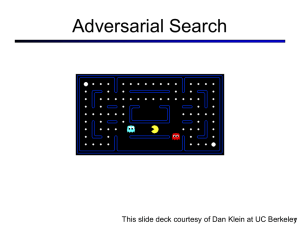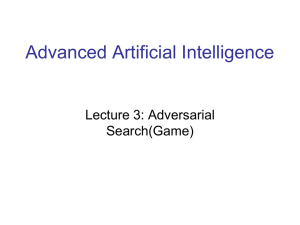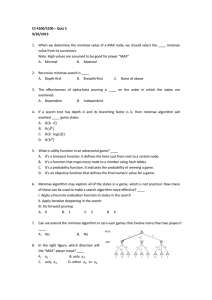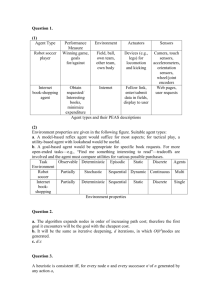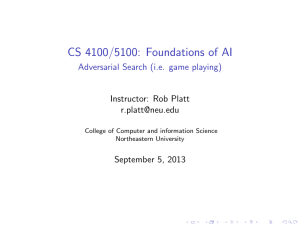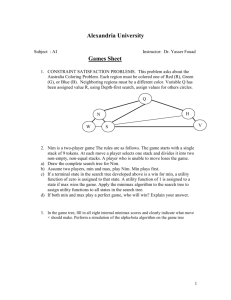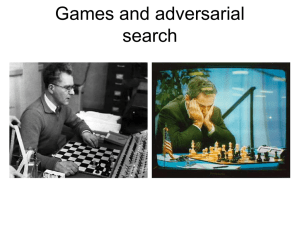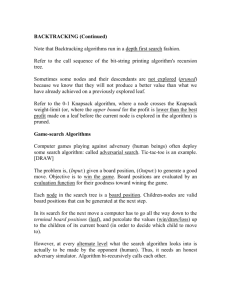CSE 473: Artificial Intelligence Spring 2014 Expectimax Search !
advertisement
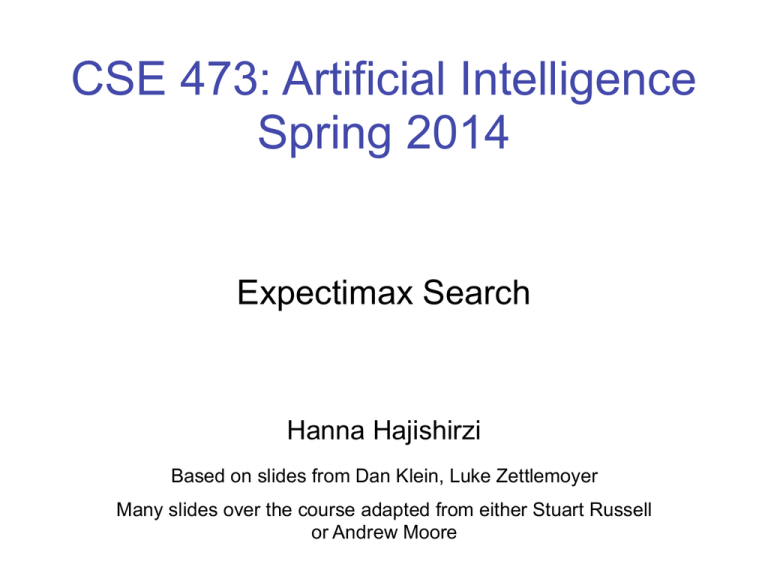
CSE 473: Artificial Intelligence
Spring 2014
Expectimax Search
!
!
Hanna Hajishirzi
Based on slides from Dan Klein, Luke Zettlemoyer
Many slides over the course adapted from either Stuart Russell
or Andrew Moore
1
Overview:
Search
Search Problems
Pancake Example: State space graph with costs as weights
4
2
2
3
3
4
3
4
2
3
2
2
3
4
3
General Tree Search
Path to reach goal:
Flip four, flip three
Total cost: 7
Search Strategies
§ Uninformed Search algorithms:
§ Depth First Search
§ Breath First Search
§ Uniform Cost Search: select smallest g(n)
§ Heuristic Search:
§ Best First Search : select smallest h(n)
§ A* Search: select smallest f(n)=g(n)+h(n)
§ Graph Search
5
Which Algorithm?
Which Algorithm?
Optimal A* Tree Search
§ A* tree search is optimal if h is admissible
§ A heuristic h is admissible (optimistic) if:
!
where
is the true cost to a nearest goal
15
Optimal A* Graph Search
§ A* graph search is optimal if h is
consistent
3
g = 10
B
h=8
G
A
h = 10
!
§ Consistency for all edges (A,a,B):
§ h(A) ≤ c(A,a,B) + h(B)
Triangular inequality
9
Which Algorithm?
Overview:
Adversarial Search
11
Single Agent
Game
Tree
Value#of#a#State#
Value#of#a#state:#
The#best#achievable#
outcome#(u)lity)#
from#that#state#
Non<Terminal#States:#
8#
2#
0#
…#
2#
6#
…#
4#
6#
Terminal#States:#
Adversarial
Game Tree
Minimax#Values#
States#Under#Agent’s#Control:#
<8#
States#Under#Opponent’s#Control:#
<5#
<10#
Terminal#States:#
+8#
Minimax Example
3
12
8
2
4
6
14
5
2
Minimax Properties
§ Optimal?
§ Yes, against perfect player. Otherwise?
max
§ Time complexity?
§ O(bm)
min
§ Space complexity?
§ O(bm)
§ For chess, b ≈ 35, m ≈ 100
10
§ Exact solution is completely infeasible
§ But, do we need to explore the whole tree?
10
9
100
Today
§ Adversarial Search
§ Alpha-beta pruning
§ Evaluation functions
§ Expectimax
!
§ Reminder:
§ Programming 1 due in one week!
§ Programming 2 will be on adversarial search
Alpha-Beta Pruning Example
2
3
5
9
0
7
4
2
1
5
6
α is MAX’s best alternative here or above
β is MIN’s best alternative here or above
Alpha-Beta Pruning Example
<=3
>=5
3
2
3
5
9
0
7
4
2
1
5
6
α is MAX’s best alternative here or above
β is MIN’s best alternative here or above
Alpha-Beta Pruning Example
3
<=0
>=5
3
2
3
5
0
0
7
4
2
1
5
6
α is MAX’s best alternative here or above
β is MIN’s best alternative here or above
Alpha-Beta Pruning Example
3
>=5
3
2
3
<=2
<=0
5
0
0
2
2
1
5
6
α is MAX’s best alternative here or above
β is MIN’s best alternative here or above
Alpha-Beta Pruning Example
3
>=5
3
2
3
<=2
<=0
5
0
0
2
2
1
α is MAX’s best alternative here or above
β is MIN’s best alternative here or above
Alpha-Beta Pruning Properties
§ This pruning has no effect on final result at the root
!
§ Values of intermediate nodes might be wrong!
§ but, they are bounds
!
§ Good child ordering improves effectiveness of pruning
!
§ With “perfect ordering”:
§ Time complexity drops to O(bm/2)
§ Doubles solvable depth!
§ Full search of, e.g. chess, is still hopeless…
Resource Limits
§ Cannot search to leaves
§ Depth-limited search
§ Instead, search a limited depth of tree
§ Replace terminal utilities with an eval
function for non-terminal positions
§ e.g., α-β reaches about depth 8 –
decent chess program
§ Guarantee of optimal play is gone
-2
-1
4
max
4
min
-2
4
?
?
min
9
§ Evaluation function matters
§ It works better when we have a
greater depth look ahead
?
?
Depth Matters
depth 2
Depth Matters
depth 10
Evaluation Functions
§ Function which scores non-terminals
§ Ideal function: returns the utility of the position
§ In practice: typically weighted linear sum of features:
§ e.g. f1(s) = (num white queens – num black queens), etc.
Bad Evaluation Function
Why Pacman Starves
Why#Pacman#Starves#
8
-2
8
! A#danger#of#replanning#agents!#
§ He knows his score will go up by eating the dot now
! He#knows#his#score#will#go#up#by#ea)ng#the#dot#now#(west,#east)#
§ He knows his score will go up just as much by eating the
! He#knows#his#score#will#go#up#just#as#much#by#ea)ng#the#dot#later#(east,#west)#
dot later on
! There#are#no#point<scoring#opportuni)es#aver#ea)ng#the#dot#(within#the#horizon,#two#here)#
! §Therefore,#wai)ng#seems#just#as#good#as#ea)ng:#he#may#go#east,#then#back#west#in#the#next#
There are no point-scoring opportunities after eating the
round#of#replanning!#
dot
§ Therefore, waiting seems just as good as eating
Evaluation for Pacman
What features would be good for Pacman?
Evaluation Function
Evaluation Function
Minimax Example
No point in trying
Expectimax
3 ply look ahead, ghosts
move randomly
Wins some of the
games
Worst-Case vs. Average Case
Worst-case vs. Average
max
min
10
10
9
100
§ Uncertain outcomes are controlled by chance not an
adversary
§ Chance
nodes arecontrolled
new types ofby
nodes
(instead
Minadve
Uncertain
outcomes
chance,
notofan
nodes)
Stochastic Single-Player
§ What if we don’t know what the
result of an action will be? E.g.,
max
§ In solitaire, shuffle is unknown
§ In minesweeper, mine locations
average
§ Can do expectimax search
§ Chance nodes, like actions
except the environment controls
the action chosen
§ Max nodes as before
§ Chance nodes take average
(expectation) of value of children
10
4
5
7
Expectimax Pseudocode
Expectimax Pseudocode
def exp-value(state):
initialize v = 0
for each successor of state:
p = probability(successor)
v += p * value(successor)
return v
1/2
1/3
5
8
v = (1/2) (8) + (1/3) (24) + (1/6) (-12) = 10
24
7
1/6
-12
Maximum Expected Utility
§ Why should we average utilities? Why not minimax?
§ Principle of maximum expected utility: an agent should
choose the action which maximizes its expected utility,
given its knowledge
§ General principle for decision making
§ Often taken as the definition of rationality
§ We’ll see this idea over and over in this course!
§ Let’s decompress this definition…
Reminder: Probabilities
§ A random variable represents an event whose outcome is unknown
§ A probability distribution is an assignment of weights to outcomes
§ Example: traffic on freeway?
§ Random variable: T = whether there’s traffic
§ Outcomes: T in {none, light, heavy}
§ Distribution: P(T=none) = 0.25, P(T=light) = 0.55, P(T=heavy) = 0.20
§ Some laws of probability (more later):
§ Probabilities are always non-negative
§ Probabilities over all possible outcomes sum to one
§ As we get more evidence, probabilities may change:
§ P(T=heavy) = 0.20, P(T=heavy | Hour=8am) = 0.60
§ We’ll talk about methods for reasoning and updating probabilities later
What are Probabilities?
§ Objectivist / frequentist answer:
§ Averages over repeated experiments
§ E.g. empirically estimating P(rain) from historical observation
§ E.g. pacman’s estimate of what the ghost will do, given what it
has done in the past
§ Assertion about how future experiments will go (in the limit)
§ Makes one think of inherently random events, like rolling dice
§ Subjectivist / Bayesian answer:
§
§
§
§
§
Degrees of belief about unobserved variables
E.g. an agent’s belief that it’s raining, given the temperature
E.g. pacman’s belief that the ghost will turn left, given the state
Often learn probabilities from past experiences (more later)
New evidence updates beliefs (more later)
Uncertainty Everywhere
§ Not just for games of chance!
§
§
§
§
§
§
I’m sick: will I sneeze this minute?
Email contains “FREE!”: is it spam?
Tooth hurts: have cavity?
60 min enough to get to the airport?
Robot rotated wheel three times, how far did it advance?
Safe to cross street? (Look both ways!)
§ Sources of uncertainty in random variables:
§
§
§
§
§
Inherently random process (dice, etc)
Insufficient or weak evidence
Ignorance of underlying processes
Unmodeled variables
The world’s just noisy – it doesn’t behave according to plan!
Reminder: Expectations
§ We can define function f(X) of a random variable X
§ The expected value of a function is its average value,
weighted by the probability distribution over inputs
§ Example: How long to get to the airport?
§ Length of driving time as a function of traffic:
L(none) = 20, L(light) = 30, L(heavy) = 60
§ What is my expected driving time?
§ Notation: EP(T)[ L(T) ]
§ Remember, P(T) = {none: 0.25, light: 0.5, heavy: 0.25}
§ E[ L(T) ] = L(none) * P(none) + L(light) * P(light) + L(heavy) * P(heavy)
§ E[ L(T) ] = (20 * 0.25) + (30 * 0.5) + (60 * 0.25) = 35
Review: Expectations
§ Real valued functions of random variables:
!
!
§ Expectation of a function of a random variable
!
!
!
§ Example: Expected value of a fair die roll
X
P
f
1
1/6
1
2
1/6
2
3
1/6
3
4
1/6
4
5
1/6
5
6
1/6
6
Utilities
§ Utilities are functions from outcomes (states of the world)
to real numbers that describe an agent’s preferences
!
§ Where do utilities come from?
§ In a game, may be simple (+1/-1)
§ Utilities summarize the agent’s goals
§ Theorem: any set of preferences between outcomes can be
summarized as a utility function (provided the preferences meet
certain conditions)
!
§ In general, we hard-wire utilities and let actions emerge
(why don’t we let agents decide their own utilities?)
!
§ More on utilities soon…
Expectimax Search Trees
§ What if we don’t know what the
result of an action will be? E.g.,
§ In solitaire, next card is unknown
§ In minesweeper, mine locations
§ In pacman, the ghosts act randomly
max
§ Can do expectimax search
§ Chance nodes, like min nodes,
except the outcome is uncertain
§ Calculate expected utilities
§ Max nodes as in minimax
search
§ Chance nodes take average
(expectation)
of value of children
!
!
§ Later, we’ll learn how to formalize
the underlying problem as a
Markov Decision Process
chance
10
4
5
7
Expectimax Search
§ In expectimax search, we have a
probabilistic model of how the
opponent (or environment) will
behave in any state
§ Model could be a simple uniform
distribution (roll a die)
§ Model could be sophisticated and
require a great deal of computation
§ We have a node for every outcome
out of our control: opponent or
environment
§ The model might say that adversarial
actions are likely!
§ For now, assume for any state we
magically have a distribution to
assign probabilities to opponent
actions / environment outcomes
Expectimax
Pruning
Expectimax Example
3
12
9
2
4
6
15
6
0
46
Expectimax
Pruning
Expectimax Pruning?
3
12
9
2
§ Not easy
§ exact: need bounds on possible values
§ approximate: sample high-probability branches
47
Depth-limited
Depth-LimitedExpectimax
Expectimax
400 300
…
492
Estimate of true
…
expectimax value
(which would
require a lot of
work to compute)
362
…
48
Expectimax Evaluation
§ Evaluation functions quickly return an estimate for a
node’s true value (which value, expectimax or minimax?)
§ For minimax, evaluation function scale doesn’t matter
§ We just want better states to have higher evaluations
(get the ordering right)
§ We call this insensitivity to monotonic transformations
§ For expectimax, we need magnitudes to be meaningful
0
40
20
30
x2
0
1600
400
900
Expectimax Pseudocode
def value(s)
if s is a max node return maxValue(s)
if s is an exp node return expValue(s)
if s is a terminal node return evaluation(s)
!
def maxValue(s)
values = [value(s’) for s’ in successors(s)]
return max(values)
8
!
def expValue(s)
values = [value(s’) for s’ in successors(s)]
weights = [probability(s, s’) for s’ in successors(s)]
return expectation(values, weights)
4
5
6
Expectimax for Pacman
§ Notice that we’ve gotten away from thinking that the
ghosts are trying to minimize pacman’s score
§ Instead, they are now a part of the environment
§ Pacman has a belief (distribution) over how they will
act
§ Quiz: Can we see minimax as a special case of
expectimax?
Quiz
Quiz: Informed Probabilities
Quiz: Informed Probabilities
! Let’s say you know that your opponent is actually running a depth 2 minimax, using the
result 80% of the time, and moving randomly otherwise
! Let’s say you know that your opponent is actually running a depth 2 minimax, using the
! Question:
What
treetime,
search
use? otherwise
result 80%
of the
andshould
movingyou
randomly
! Question: What tree search should you use?
! Answer: Expectimax!
To figure out EACH chance node’s probabilities,
! !Answer:
Expectimax!
0.1
0.1
0.9
0.9
you have to run a simulation of your opponent
! To figure out EACH chance node’s probabilities,
! This
very slow
veryopponent
quickly
youkind
haveof
tothing
run agets
simulation
of your
!! Even
worse
you gets
havevery
to simulate
This kind
of ifthing
slow veryyour
quickly
opponent simulating you…
! Even worse if you have to simulate your
! …opponent
except for
minimax,you…
which has the nice
simulating
property that it all collapses into one game tree
! … except for minimax, which has the nice
property that it all collapses into one game tree
52
Expectimax for Pacman
Results from playing 5 games
Minimizing
Ghost
Random
Ghost
Minimax
Pacman
Won 5/5
Avg. Score:
493
Won 5/5
Avg. Score:
483
Expectimax
Pacman
Won 1/5
Avg. Score:
-303
Won 5/5
Avg. Score:
503
SCORE:
0
Pacman does depth 4 search with an eval function that avoids trouble
Minimizing ghost does depth 2 search with an eval function that seeks Pacman
Mixed Layer Types
§ E.g. Backgammon
§ Expectiminimax
§ Environment is an
extra player that moves
after each agent
§ Chance nodes take
expectations, otherwise
like minimax
Stochastic Two-Player
§ Dice rolls increase b: 21 possible rolls
with 2 dice
§ Backgammon ≈ 20 legal moves
§ Depth 4 = 20 x (21 x 20)3 1.2 x 109
§ As depth increases, probability of
reaching a given node shrinks
§ So value of lookahead is diminished
§ So limiting depth is less damaging
§ But pruning is less possible…
§ TDGammon uses depth-2 search +
very good eval function +
reinforcement learning: worldchampion level play
Multi-player Non-Zero-Sum Games
§ Similar to
minimax:
§ Utilities are now
tuples
§ Each player
maximizes their
own entry at
each node
§ Propagate (or
back up) nodes
from children
§ Can give rise to
cooperation and
competition
dynamically…
1,2,6
4,3,2
6,1,2
7,4,1
5,1,1
1,5,2
7,7,1
5,4,5
